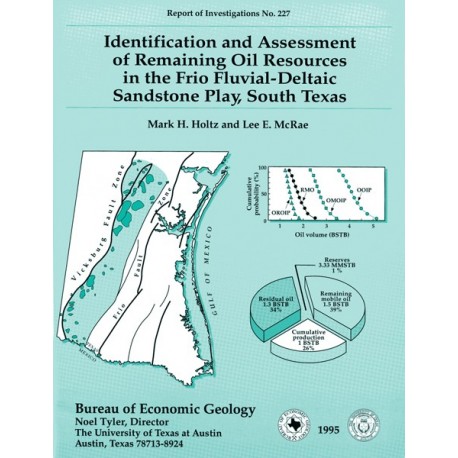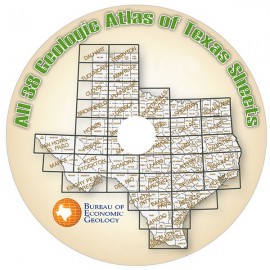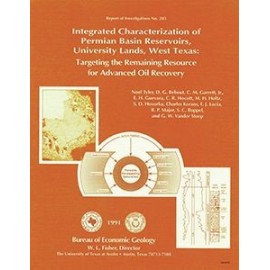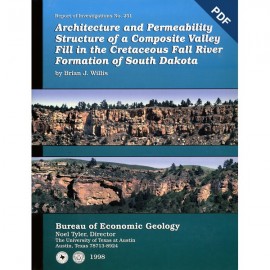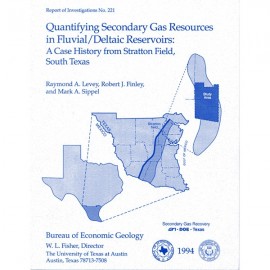Reports of Investigations
-
Books & Reports
- Reports of Investigations
- Guidebooks
- Udden Series
- Geological Circulars
- Down To Earth
- Atlases of Major Oil and Gas Reservoirs
- Texas Memorial Museum Publications
- Environmental Geologic Atlas of the Texas Coastal Zone
- Mineral Resource Circulars
- Other Reports
- Seminars and Workshops
- Handbooks
- Submerged Lands of Texas
- Symposia
- Annual Reports
- Open File Reports
-
Maps & Cross Sections
- Thematic Maps
- Miscellaneous Maps, Charts & Sections
- Geologic Atlas of Texas
- STATEMAP Project Maps
- Geologic Quadrangle Maps
- Cross Sections
- Highway Geology Map
- Energy and Mineral Resource Maps
- Shoreline Change and Other Posters
- Wilcox Group, East Texas, Geological / Hydrological Folios
- Bouguer Gravity Atlas of Texas
- River Basin Regional Studies
- Featured Maps
- Posters
- Teachers & the Public
-
Geological Society Publications
- Gulf Coast Association of Geological Societies
- Alabama Geological Society
- Austin Geological Society
- Corpus Christi Geological Society
- Houston Geological Society
- Lafayette Geological Society
- Mississippi Geological Society
- New Orleans Geological Society
- South Texas Geological Society
- GCS SEPM Publications
- Historic BEG & UT Series
Identification and Assessment of Remaining Oil Resources in the Frio Fluvial-Deltaic Sandstone Play, South Texas
RI0227
For a downloadable, digital version: RI0227D.
RI0227. Identification and Assessment of Remaining Oil Resources in the Frio Fluvial-Deltaic Sandstone Play, South Texas, by M. H. Holtz and L. E. McRae. 46 p., 33 figs., 7 tables, 1995.
To purchase this publication as a downloadable PDF, please order RI0227D.
ABSTRACT
The Frio Fluvial-Deltaic Sandstone (Vicksburg Fault Zone) play of South Texas has produced nearly 1 billion barrels (Bbbl) of oil since field development began in the 1940's. More than half of the reservoirs in this depositionally complex play have been abandoned, although large volumes of oil remain. A sizeable resource may remain unproduced unless methods integrating geological and engineering reservoir characterization are developed to identify the location of unrecovered mobile oil, estimated at more than 1 Bbbl, that remains in undrained reservoir zones in fields within this mature play.
To estimate the volume of oil resources remaining in this prolific play and to assess the potential of reservoirs for containing zones that have additional unproduced oil, geologic and engineering characteristics of reservoirs in fields throughout the play were evaluated. Sandstone reservoirs within the play represent depositional facies that include aggradational fluvial-channel sandstones, mixed aggradational-progradational fluvial- and distributary-channel sandstones, and progradational delta-front sandstones. The differing stratigraphic context of these types of fluvial-deltaic reservoirs within the play results in differences in engineering attributes and internal heterogeneity that may significantly affect reservoir quality and hydrocarbon recovery efficiency, thereby affecting the potential for additional recovery.
Reservoir engineering attribute data were statistically analyzed from oil and gas fields throughout the geographic play area. General reservoir attributes used to characterize Frio fluvial-deltaic sandstone reservoirs included porosity, initial water saturation, residual oil saturation, net pay, reservoir area, and fluid characteristics. Statistical analysis of variance demonstrated no difference between oil and gas reservoir attributes, supporting the interpretation that oil and gas reservoirs are subsets of a larger genetically similar population. Probability functions that best describe attribute frequency distributions were determined for use in risk-adjusting resource calculations. Different probability functions were found to be most applicable for the various petrophysical reservoir attributes. Statistical tests suggest that the Weibull function most accurately represents the frequency distribution of reservoir volumes, including original oil in place (OOIP), original mobile oil in place, and residual oil in place. This finding is in contrast to convention that generally assumes a lognormal distribution. Use of a Weibull distribution to simulate probable reservoir volumes results in lower values for the oil-in-place resource estimate than those calculated by using average reservoir parameters.
The Frio Fluvial-Deltaic Sandstone play contains large volumes of remaininoil. The volumetric probability distribution between 5- and 95-percent probability for OOIP ranges from 3.8 to 5.6 billion stock-tank barrels (BSTB), original mobile oil in place ranges from 2.5 to 3.6 BSTB, and residual oil ranges from 1.5 to 2.3 BSTB. The remaining mobile oil, at the 95-percent probability level, is at least 1.2 BSTB. Additionally, the untapped oil resource (sandstone bodies not connected to a well bore) may be 10 percent of the OOIP, or 380 million stock-tank barrels (MMSTB).Reservoir characterization coupled with proper reservoir management techniques can be applied to recover additional mobile oil in this play as well as in other analogous reservoirs.
Keywords: fluvial-deltaic, Frio, probability functions, reserve growth, reservoir heterogeneity, Rincon field, risk assessment, stochastic, Texas, Weibull
CONTENTS
Abstract
Introduction
Regional Geologic Framework of the Frio Fluvial-Deltaic Sandstone Play
Structural and Stratigraphic Setting
The Upper Vicksburg-Frio Genetic Stratigraphic Sequence
Upper Vicksburg Reservoirs
Depositional History
Reservoir Facies and Heterogeneity Style
Lower Frio Reservoirs
Depositional History
Reservoir Facies, Heterogeneity Style, and Primary Targets for Incremental Recovery
Middle and Upper Frio Reservoirs
Depositional History
Reservoir Facies, Heterogeneity Style, and Primary Targets for Incremental Recovery
Statistical Evaluation of Petrophysical Attributes of Frio Reservoirs
Data Sources
Risk Assessment of Reservoir Attributes
Methods
Reservoir Attributes of Frio Fluvial-Deltaic Sandstones
Reservoir Porosity
Statistical Characteristics
Descriptive Probability Functions
Reservoir Initial Water Saturation
Statistical Characteristics
Descriptive Probability Functions
Reservoir Residual Oil Saturation
Statistical Characteristics
Descriptive Probability Functions
Reservoir Net Pay
Statistical Characteristics
Descriptive Probability Functions
Reservoir Area
Statistical Characteristics
Descriptive Probability Functions
Reservoir Fluid Characteristics
Oil Gravity
Oil Bubble-Point Pressure
Oil Viscosity
Oil Formation Volume Factor
Field-Scale Analysis of Reservoir Attributes
Methods
Reservoir Attributes of Rincon Sandstones
Production Characteristics of Rincon Sandstones
Oil-Volume Characteristics of Reservoirs in the Frio Fluvial-Deltaic Sandstone Play
Methods
Original Oil in Place per Acre
Simulation Results
Best-Fit Probability Functions for Volume Distributions
Residual Oil per Acre
Simulation Results
Best-Fit Probability Functions for Volume Distributions
Original Mobile Oil per Acre
Simulation Results
Best-Fit Probability Functions for Volume Distributions
Ultimate Reserve Characteristics
Potential for Reserve Growth of Reservoirs in the Frio Fluvial-Deltaic Sandstone Play
Incompletely Drained Oil Resource
Untapped Oil Potential
Summary
Acknowledgments
References
Figures
1. Range of recovery efficiencies reported for various clastic oil reservoirs in Texas
2. Schematic geologic cross section contrasting the generalized interpretation of a sandstone reservoir as a simple, laterally continuous producing zone with a more detailed interpretation of the same sandstone unit as a complex heterogeneous zone consisting of multiple reservoir compartments.
3. Pie diagrams illustrating the distribution of original oil in place (OOIP), cumulative oil, produced, and current estimates of remaining mobile oil resources in Texas oil reservoirs representing various clastic depositional facies
4. Histogram illustrating number and cumulative frequency of reservoirs discovered in the Frio Fluvial-Deltaic Sandstone play, 1926 through 1978
5. Distribution of the location of oil resources within reservoirs of the Frio Fluvial-Deltaic Sandstone play in South Texas
6. Histogram illustrating trends of decline in annual production and increase in reservoir abandonment in the Frio Fluvial-Deltaic Sandstone play since 1968
7. Map of South Texas showing location of fields within the Frio Fluvial-Deltaic Sandstone play along the Vicksburg Fault Zone
8. Generalized west-to-east cross section through Rincon field illustrating structural setting of a representative field in the Frio Fluvial-Deltaic Sandstone play
9. Stratigraphic column of Cenozoic sediments of the South Texas Gulf Coast
10. Schematic northwest-southeast cross section of the South Texas Gulf Coast Basin
11. General distribution of the Norias delta and Gueydan fluvial depositional systems responsible for deposition of the Frio stratigraphic unit
12. Chronostratigraphic and sediment-stacking-pattern relationships of the upper Vicksburg-Frio genetic stratigraphic interval, lower South Texas Gulf Coast, illustrated with a representative log from Rincon field, Starr County, South Texas
13. Schematic block diagram illustrating general three-dimensional relationships and characteristic SP log responses in fluvial-deltaic reservoir and nonreservoir facies
14. Flowchart outlining steps used in assessing remaining oil resources in the Frio Fluvial-Deltaic Sandstone play
15. Comparison of the normal frequency distribution curve with curves for lognormal, gamma, and logistic probability density functions
16. Comparison of normal frequency distribution curve with curves for exponential, Pareto, and Weibull probability density functions
17. Histogram illustrating distributions for values of reservoir porosity from reservoirs throughout the play and cumulative frequency comparing actual porosity data with best-fit probability function
18. Histogram and various function fits illustrating distributions for values of reservoir initial water saturation throughout the play
19. Histogram illustrating distributions for values of reservoir residual oil saturation throughout the play and cumulative probability distribution curves comparing actual reservoir residual oil saturation with a logistic function fit
20. Histogram illustrating distributions for values of reservoir net pay throughout the play and cumulative probability distribution comparing actual reservoir net pay values with a lognormal function fit
21. Histogram illustrating distributions for values of reservoir area throughout the play and cumulative probability distribution comparing actual oil and gas reservoir area with a lognormal function fit
22. Histogram of oil gravity illustrating the lightness of the oil
23. Histogram of oil viscosity illustrating bimodal distribution
24. Histograms showing frequency distributions for values of core porosity and permeability from various fluvial-deltaic reservoir groups within the productive Frio-Vicksburg stratigraphic interval
25. Expanded type log from Rincon field of lower and middle Frio reservoirs illustrating reservoir nomenclature of individual producing units and the stratigraphic distribution of oil and gas production
26. Cross plots of porosity and permeability values measured from wireline cores in representative Frio reservoirs in Rincon field
27. Cumulative probability distribution illustrating the Weibull probability function as the model for the variation of OOIP per acre
28. Cumulative probability distribution comparing actual simulation results of residual oil with a best-fit beta function model
29. Cumulative probability distribution of original mobile oil in place per acre comparing actual simulation results with the Weibull function model
30. Histogram of ultimate reserves illustrating tendency of most reservoirs to contain small reserves
31. Probability distribution curves illustrating the cumulative probability of original oil in place, original residual oil, original mobile oil, and remaining mobile oil for the Frio Fluvial-Deltaic Sandstone play
32. Estimation of number of reservoir sandstones within a producing field based on modeling occurrences of pay zones and reservoir sandstone bodies
33. Modeled cumulative probability distribution curve illustrating potential of untapped oil in reservoirs within the Frio Fluvial-Deltaic Sandstone play
Tables
1. Summary of characteristics within each of the stratigraphic subdivisions of the upper Vicksburg-Frio stratigraphic interval
2. Statistics for reservoir parameters grouped by oil, gas, and combined data sets
3. Results of ANOVA testing, indicating that most parameter means of oil and gas reservoirs are not significantly different
4. Reservoir statistics and production summary as of 1991 for Rincon field
5. Summary of general reservoir attributes for individual productive Frio sandstone zones in Rincon field
6. Summary of the best-fit probability density functions for modeling the reservoir engineering attributes
7. Major oil reservoirs in the Frio Fluvial-Deltaic Sandstone (Vicksburg Fault Zone) play
Citation
Holtz, M. H., and McRae, L. E., 1995, Identification and Assessment of Remaining Oil Resources in the Frio Fluvial-Deltaic Sandstone Play, South Texas: The University of Texas at Austin, Bureau of Economic Geology, Report of Investigations No. 227, 46 p.
